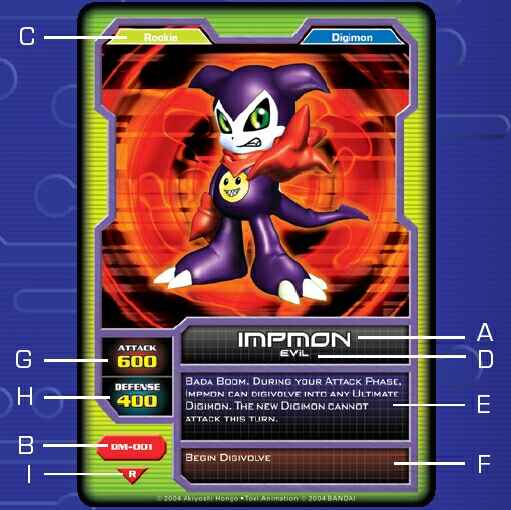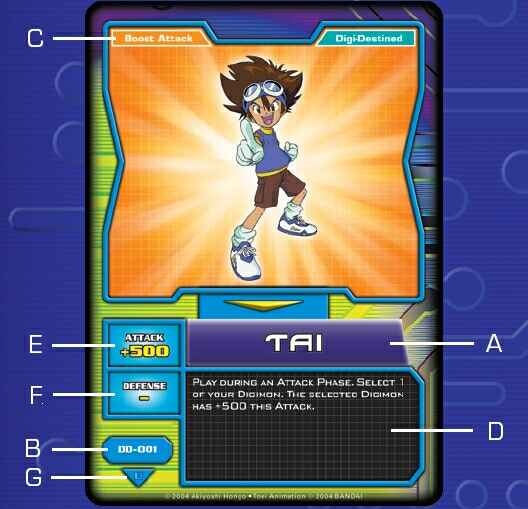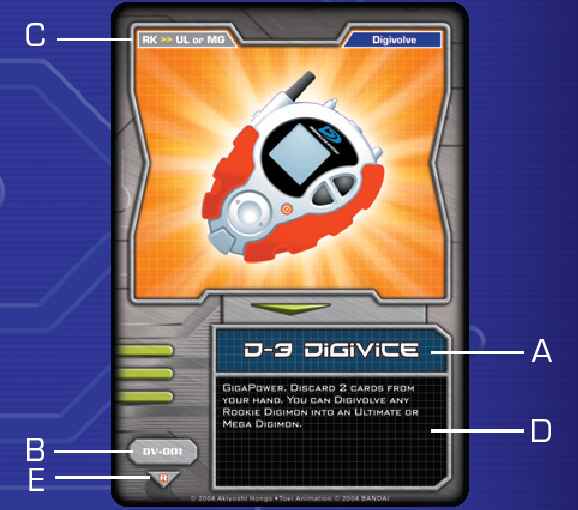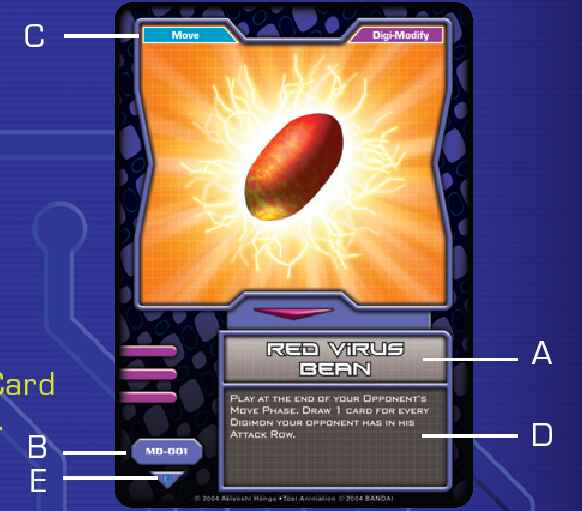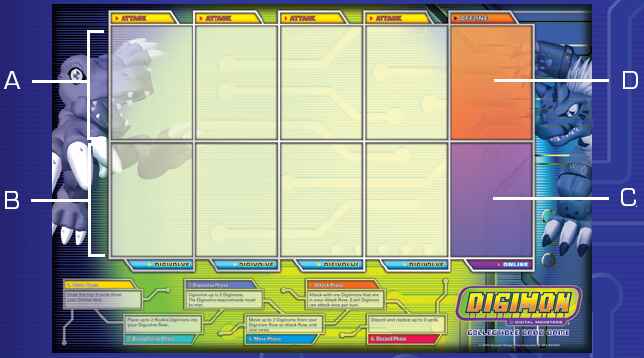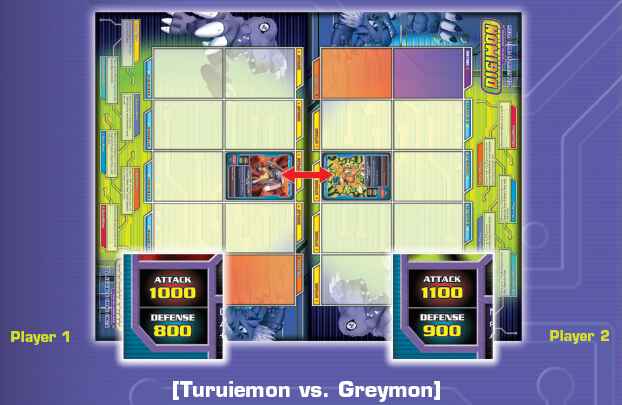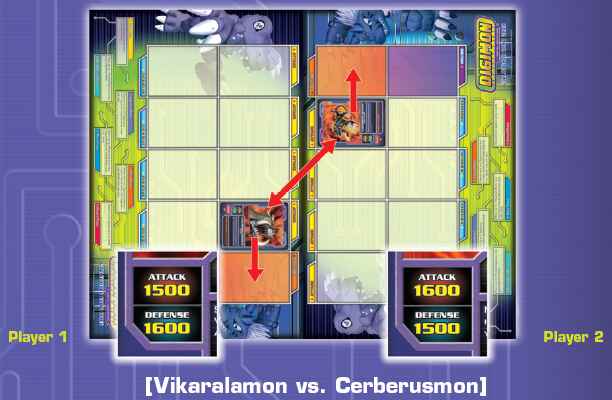
 Splash
Disclaimer Privacy Policy About Message Archive Q&A Staff Affiliates   Other Sites   Downloads Credits Stores Trade Lists Contact     |
Digimon CCG
Articles
Digimon CCG (for beginners): Rules
[Note: This article is not up-to-date. Check everything against current erratas and rulings. More info and an update coming soon. Check the home oage for more details on when.] This is an article meant to introduce new players to the Digimon CCG and help players from older Digimon card games to adapt to this one (as this one is quite different from all before it). This article will cover the rules of the game. An analysis of each type of card and a few basic tips for using the cards (like timing and what type to use when, and a few combos and stratagies) will be in another article, and yet another article will follow later on giving different stratagies for different deck combinations. Because of the way this game is made and played, each deck may have a completely different set of stratagies and combos to another deck with similar cards -It's up to each player to customize (and/or create) their own deck and use stratagies and combos that compliment it and work with it. A small tip on this is to make sure your deck can be flexable with multiple stratagies and combos that can be applied to more than a handful of situations. Very Important: Read the rules of the game first. You can find these rules at www.digimonccg.com or in the rule book that comes with a Starter box. I've typed the rules out for the sake of having an easy reference, but if you've already read the rules you can skip the bulk in the blue background (I will refer to the rules in later articles, but will have the quote from the rules there so you don't have to keep switching back and forth between articles). First, we will take a look at the rules as given in the rule book of a series 1 Starter. Rules:
Also unless otherise stated, according to Customer Support, a Digimon's Special Effect has to be activated at the start of the Attack Phase before any of your Digimon start an Attack. (The Special Effects are also 'common-sense based', which means there aren't any 'lawyering rules' about the Special Effects.)
The sentence "Each player needs at least 50 cards in his deck to play." means that you have to have 50 or more cards in your deck -there is technicaly no limit to how many cards you can have in your deck. However, do not confuse this with how many copies of a card you can have... You're Still only allowed 3 copies of any card in your deck and only 1 copy of GigaPower cards... Although the rules don't specificaly state this (for some strange reason), it's important to note here that, unlike previous Digimon card games, this game goes through every phase of the game within a single player's turn. Then the player's turn ends and the next player goes through every single phase of the game through her/his/it's turn, and so on. If this isn't kept in mind, the game won't seem to make much sense.
Not to mention that Mega may occasionaly Digivolve to Mega too, like Gallantmon to Gallantmon (Crimson Mode), and Champion may occasionaly Digivolve to Champion, like Gatomon to Lynxmon... no, Megas Digivolving to each other isn't realy possible in the Digimon universe as Mega (known as 'Final' or 'Ultimate' in the Japanese card game) is the highest level you get and Megas can only fuse or mode change, but Customer Support *did* say that a few rules had to be broken to make this game function (although I can see a way around it so that Megas still don't Digivolve...). What I can't figure out is why Gatomon Digivolves to another Champion when there are no Digi-Eggs or Armor Digivolutions in this game so far... Lynxmon comes from Gatomon and also comes from an Elecmon (Rookie level)...
Customer Support has informed me that the order in which the Digimon is moved is (1.) you may move up to 2 Digimon from the Digivolve Row to the Attack Row (if you so desire), and only after that (2.) you may move up to 2 Digimon from the Attack Row to the Digivolve Row (if you so desire). 'Well, what's the point in pointing that out?', you ask? If you have more than 2 Digimon in the Attack Row and you want to move more than 1 Digimon to the Attack Row, moving all the Digimon around will take a few turns, and that means having to be creative in the way you do that so your Digimon don't get defeated... Makes the game more... 'interesting'. : )
Just a note... In the actual game itself, 'Discard' means 'send from hand to the Offline Pile' and 'Offline' means 'send from the playmat to the Offline Pile'. The 'playmat' in gameplay is a player's Attack and Digivolve Rows -the Offline and Online Piles are not counted as part of the Playmat.
For the record, when ever a card is Discarded or a Digimon is Offlined, the card/Digimon goes to it's respective player's Offline Pile -your cards should never go to an opponent's Offline Pile and an opponent's cards should never go to your Offline Pile.
Some cards have effects that are used during this Phase.
Here it's important to note that the Digiqueue only applies to interaction between the players. If you're, say, using Digi-Destined Boost Attack cards to power up your Digimon before you attack, then there's no interaction between you and another player. In that case, the effects of the cards are resolved in the order the cards are played, a card's effect resolving before the next card is played. This also applies to when a player is playing Modify cards with no interaction between the player and another player.
Decks have to have *at least* 50 cards in it. There is no maximum for the amount of cards you're allowed in your deck, although the more cards you have in it the less the chances of drawing the cards you need when you need them (this early in the game anyway...)
The exception to this is DD-020 Mimi because the wording on the card states that the Boost Defense power is gives lasts until the end of the turn. You can find a card list somewhere else on this site or on the Products page of www.digimonccg.com . This wasn't mentioned in the rules (because it was only suggested to the Game Team after the game was released), but this game can be played as a multiplayer game. I suggest 3-6 players only for multiplayer because more than that can get rather confusing... Also, it's not suggested that multiplayer be played through the internet (through instant messengers and such) because that can be even more confusing. If multiplayer is going to be used through the internet, a special program for internet play should be made (which isn't exactly easy... ). These are the multiplayer rules -all the regular game rules apply unless stated otherwise: 1.) No player may attack on his/her/it's first turn. This keeps the game fair. If a player has a Digimon on their playmat who's Special Effect requires them to give up the Digimon's attack, then that Special Effect can not be used on the first turn (because that Digimon would not have an attack to give up). 2.) If you play a Digi-Modify card during another player's turn, the Modify card effects that player (and that player only). 3.) If your Digimon is going to attack and it's Special Effect effects the opposing player's Digimon (or Digimons, depending on whether your Digimon's Special Effect effects just 1 of your opponent's Digimon or all of them), the Special Effect only effects the opponent you're going to attack. 4.) If you play a Modify card during your turn that effects the opponent, you choose 1 opponent for the card to effect. You should choose which opponent the card will effect when you play the card. 5.) If you're being attacked, your Digimon's Special Effect effects any opponent that's attacking you. If I find any other rules need to be added, they will be added later.
For a little modification to this... : Teams: Each team must have the same number of players on it, for the sake of fair play, unless all players agrees otherwise (the agreeing otherwise thing may not be possible in tournaments...). The members of a team work together but may not see the cards in eachother's hands or Online Piles. Players may not attack each other or use card effects against each other. All Data Points gathered goes to the team pool. The amount of Data Points needed to win depends on the amount of teams playing and the number of members on each team. I suggest 7,500 Data Points per player in the game should be the amount a team needs to reach to win. Cooperative Teams: All the rules for regular team play applies, except: 1.) Team players may see the cards in eachother's hands. 2.) A Digimon's Special Effect that adds Attack or Defense power to another Digimon may be applied to any other Digimon on that player's team. 3.) You may use your Digi-Destined cards on a Digimon belonging to another team member. 4.) When you play a Digi-Modify card during an opponent's turn, you may transfer the effects of the card from you and/or your Digimon (depending on the effect of the card) to another member of your team or his/her Digimon (again, depending on the effect of the card). Example: If you play MD-018 Ice Arrow during an opponent's turn, which stops the opponent from attacking you, you may transfer the effect to another member of your team to that it prevents him/her from being attacked by that opponent instead of you. If you transfer the effects of a card to another member of your team and the card has a requirement before it can be used, either you or the team member you're transfering the card's effect to may fulfill the card's requirement. Any cards you play still goes to your Offline Pile, not your teammates Offline Pile. Free For All: You can attack any other player's Digimon, but a player can not be attacked twice in a row. This simply means that if there's 4 players in the game (yourself included), if you attack each one of them or their Digimon with one of your Digimon, the player who goes after you can't attack anyone except you (since you'd be the only person who didn't get attacked on your turn). Since a player can't be attacked 2 turns in a row, for your own sake (unless you've got a good strategy) you'd want to avoid attacking all the opponents on your turn because that means you'd be the only one that can be attacked on the next player's turn. This also makes things interesting as to who can be attacked when. Of course, unless the player that went before you didn't attack at all, there would be a restriction on who you can attack (because a player can't be attacked 2 turns in a row). This makes for a high-strategy game and extremely smart gameplay since each player would be against all the other players... The first player to score 7,500 Data Points wins. For a variation, you could start at 7,500 and subtract the difference in power from your opponent's Data Points when your Digimon wins an attack over that opponent's Digimon, and subtract Data Points directly from your opponent when your Digimon gives a direct attack (just the opposite of what's done in the rules at the moment, basicaly) and play an elemination match where the last person still in the game wins. Which type of Free For All match it is (First to reach 7,500 or an Elimination match) should be discussed and agreed apon by all players playing in the game before the game starts, for the sake of fairness. A third variation is if the game starts out as a 'First to reach 7,500' until one player wins, and then turns into an 'Elimination Match' to see who gets second place. In a case like that, the remaining players don't start at 7,500 Data Points but rather at however many Data Points they've already gotten in the game. All other Elimination rules apply. This should also be discussed and agreed apon by all players playing the game before the game starts. Structured Attacks: You may only attack the player to your right or left, so the players would have to be in a 'circle' of some sort (like who goes first, second, third, ect. ). This won't work for only 3 players as everyone can attack everyone else then, so you'd need 4 or more players (but I still suggest no more than 6). This can also work for team play, but it'd require 'creativity' as to what order the players take their turns in for it to work effectively. Because of the 'left or right only' restriction on attacking, you may want to try working with other players you can't attack in order to win. This can also be used in a 'First player/team to reach 7,500 Data Points wins' and then turn into an 'Elimination Match' to see who comes in second. Just remember that, with the second-place Elimination method, all members of a team share a pool of Data Points, so any mistakes a single player makes will effect the whole team. Also keep in mind that if you're working with someone who you can't attack, that person may turn into an opponent again with the elimination method as players/teams get eliminated. (If a team's Data Points reaches 0, all members of that team are eliminated since they share the same Data Points, which would now be 0) Keep in mind that none of the Multiplayer rules are official (at least at this time), so Customer Support has no obligation to help you if you come across any errors or anything like that. If you Do come across errors or questions you need answers to, feel free to contact me through this site or post your questions on the official Digimon CCG message board in http://forums.digimonccg.com/showthread.php?t=81. Enjoy! ^ ^ -CyberDramon |
